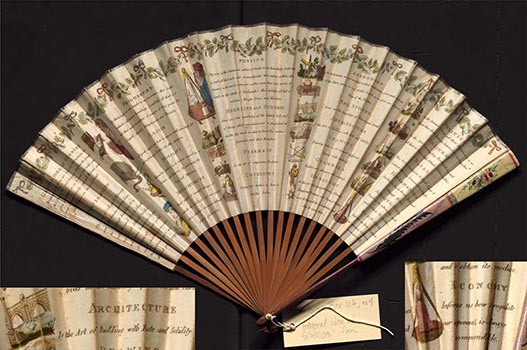
The leaf of a late eighteenth-century folding fan held at the Clark Library titled General Idea of Sciences lists, as its final item, “Economy: Informs us how to regulate our expences & is always commendable.” “Architecture,” meanwhile, “Is the Art of Building with Taste and Solidity.” Delegating only two branches of the Vitruvian triad to architecture, “utility” could be distributed to other “sciences,” like economy. The fan’s gilded top, its hand-colored illustrations, and its polished mahogany guards mark it as a luxury product. If economy is the practice of managing limited resources, the fan is itself a symbol of the rewards of frugality: surplus, and thus access to imperial opulence.
Mahogany came from the Caribbean. Mahogany trees, valuable objects in themselves, were clear-cut by teams of enslaved and free racialized lumberjacks to make way for sugar cane planting, an even more profitable enterprise. Forced to work, people of African descent made sugar and mahogany available to European consumers. As the enslaver who wrote A Letter to a Member of Parliament, Concerning the Importance of Our Sugar-Colonies to Great Britain (1745), also in the Clark’s collection, makes clear, Europeans justified Caribbean colonial products as perquisites of their practice of “economy.” The anonymous author lobbies readers not to increase taxes on sugar production for the sake of availability of a commodity that the general public assumes they are entitled to expect at large volumes and low prices. Citing overhead costs of buildings, enslaved human capital, and draft animals, the pamphlet singles out “His Negro-Slaves, which is the principal Article” necessary for sugar production. Architectural capital, too, played a significant role in this economy, from the houses in which enslaved people lived to the buildings for sugar cane-processing machinery, to enslavers’ mansions in the Caribbean and in the metropole, which commonly featured mahogany fittings. Yet mahogany was not the only building material to make the transoceanic passage. In the westward direction, the author notes, enslavers “must have a House to live in, and Furniture…. To build his House he must have many materials from England, such as Nails, Hinges, Locks, Bolts, &c. and his Furniture and Cloathing entirely from England.” Construction labor, it went without saying, would be performed by enslaved people.
I have had the privilege of joining the Clark as a postdoctoral fellow during the 2022-2023 core program, “The Forgotten Canopy: Ecology, Ephemeral Architecture, and Imperialism in the Caribbean, South American, and Transatlantic Worlds,” where my research has focused on tracing mahogany from the British Caribbean through successive stages to its use in architectural spaces. The lesson that I take from “The Forgotten Canopy” is that to “regulate our expences,” as the General Idea of the Sciences fan would have it, is not the expectation of economic returns. Rather, this year’s events have prompted me to speculate on an alternative notion of “economy” that sets aside the quantitative valuation of commodities like mahogany and sugar, as well as labor, and, indeed, humans, in favor of concentrating on knowledge in material practices. I look forward to pursuing avenues of research that regard materials and the built environments they constitute as processes: not ends, but physical testaments to human creativity, ingenuity, skill, and intelligence.
-Jonah Rowen, Ahmanson-Getty Postdoctoral Fellow

